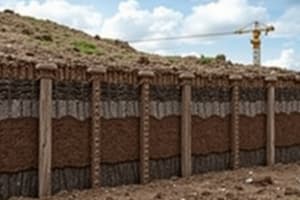Podcast
Questions and Answers
Hydrometer analysis is used for determining the grain-size distribution of coarse-grained soil.
Hydrometer analysis is used for determining the grain-size distribution of coarse-grained soil.
False (B)
Sieve analysis involves passing soil through progressively coarser sieves.
Sieve analysis involves passing soil through progressively coarser sieves.
False (B)
The specific gravity of soil is an index property considered in geotechnical properties.
The specific gravity of soil is an index property considered in geotechnical properties.
True (A)
The grain-size distribution of fine-grained soil can be determined using sieve analysis.
The grain-size distribution of fine-grained soil can be determined using sieve analysis.
The cumulative percentage of soil passing through each sieve in a sieve analysis is referred to as percent finer.
The cumulative percentage of soil passing through each sieve in a sieve analysis is referred to as percent finer.
Soil is defined as the cemented aggregate of mineral grains and decayed organic matter.
Soil is defined as the cemented aggregate of mineral grains and decayed organic matter.
Foundation engineering involves the design of foundations for various structures, including buildings and bridges.
Foundation engineering involves the design of foundations for various structures, including buildings and bridges.
The primary focus of foundation engineering is only on the soil mechanics without considering rock mechanics.
The primary focus of foundation engineering is only on the soil mechanics without considering rock mechanics.
Liquid and gas occupy the empty spaces between solid particles in soil.
Liquid and gas occupy the empty spaces between solid particles in soil.
Retaining walls are not considered in the analysis and design of earth-retaining structures in foundation engineering.
Retaining walls are not considered in the analysis and design of earth-retaining structures in foundation engineering.
Flashcards are hidden until you start studying
Study Notes
Course Introduction
- CE427 focuses on Foundation Engineering and includes a review of soil classification.
- Instructors: Engr. Vera Karla Caingles and Engr. Christian Linares.
Understanding Soil
- Soil is an uncemented mixture of mineral grains, decayed organic matter, liquid, and gas.
- It occupies the interstitial spaces between solid particles.
Foundation Engineering
- Application of soil mechanics and rock mechanics principles in designing foundations for structures like buildings, bridges, and retaining walls.
- Involves analyzing and designing earth-retaining structures, such as sheet-pile walls and braced cuts.
Geotechnical Properties of Soil
- Index Properties: Include specific gravity, particle size and shape, and relative density or consistency of soil.
- Grain-Size Distribution:
- Coarse-grained soil assessed using sieve analysis.
- Fine-grained soil analyzed through hydrometer analysis.
Sieve Analysis
- A method for determining the grain-size distribution of soil.
- Involves passing dry, pulverized soil through a series of sieves.
- Cumulative percentage of soil passing each sieve is calculated, referred to as percent finer.
Grain-Size Distribution Curves
- Curve II: Well-graded soil with uniformity coefficient > 4 for gravels and > 6 for sands, coefficient of gradation between 1 and 3.
- Curve III: Gap graded soil with certain size particles missing, forming a hump in the curve.
Size Limits for Soil
- Organizations define size categories for gravel, sand, silt, and clay based on grain sizes present in soils.
Plasticity and Activity
- Correlation between Plasticity Index (PI) and clay-size fractions varies among clay types.
- Karl Skempton defined "activity" quantifying this correlation, expressed as a slope between PI and % finer than 2 mm.
Volume-Weight Relationships
- Understanding soil elements in natural states and their three phases aids in calculating relevant geotechnical properties.
Soil Classification Systems
- Major systems include:
- AASHTO (American Association of State Highway and Transportation Officials) System.
- Unified Soil Classification System (ASTM).
Historical Perspective of Soil Mechanics
- The era between 1910-1927 featured significant studies on clay behavior, including Atterberg limits by Atterberg (1911) and consolidation theory by Terzaghi (1925).
Contributions of Karl Terzaghi
- Pioneering figure in Geotechnical Engineering, born on October 2, 1883, in Prague.
- Key contributions: effective stress, elastic stress distribution, consolidation settlement, and shear strength.
- Recipient of the Norman Medal from ASCE four times; awarded nine honorary doctorates across eight countries.
- His work laid the foundation for modern soil mechanics and geotechnical engineering practices.
Studying That Suits You
Use AI to generate personalized quizzes and flashcards to suit your learning preferences.




